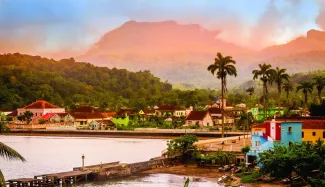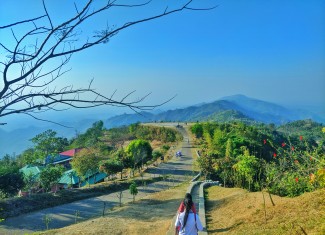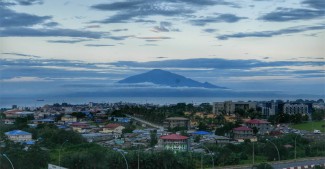Tourism, apparel and sustainable development strategies are covered in new series of policy briefs from the Enhanced Integrated Framework
International trade can be a powerful tool for least developed countries (LDCs) to reduce poverty and spur economic growth. But it is not a blanket solution.
Individual country contexts, government planning and prioritizing, the private sector situation and other particularities – not to mention consumer preferences and global trends – intermingle in spurring (or not) trade’s development. Being able to take advantage of the opportunities available, and to create one’s own, requires awareness and action, and the leveraging of targeted support in order to get trade working for LDC populations.
A recently launched series of three briefs by the Enhanced Integrated Framework (EIF) is addressing these needs, looking into areas of special relevance for LDCs working to boost their presence in global trade. For over ten years EIF has been working with LDC governments to build strong trade institutions and policies and to support local trade sectors with promise; this new analysis builds on that experience and is part of its trade support.
Using case studies from various countries as models, the briefs offer an overview of critical trade topics and include a set of recommendations for action.
How can an LDC ensure its trade development is sustainable? Could tourism become part of pandemic response support? Where in the garment industry’s value chain can resilience be strengthened?
The policy briefs ask and answer these questions and others, with a special focus on COVID-19 impacts and responses, offering detailed examples from the Solomon Islands to Zambia to Bangladesh. Here’s a snapshot of what is covered.
Trade integration and sustainable development
Trade is not necessarily a part of a country’s development strategy. It needs to be embedded at the national level by people in government, and this is not necessarily a straightforward process.
By what is termed “mainstreaming trade”, countries are recognizing the cross-cutting effects of doing so, that economic, social and environmental dimensions are intertwined. LDCs can and should learn from what others have done, the Integrating trade in the sustainable development strategies of least developed countries brief notes.
Cambodia, for example, has made huge strides in reducing poverty and achieving its development objectives. And international trade and investment have played a major role in the country sustaining an average growth rate of 7.9% from 1997-2017.
The country saw success mainstreaming trade by strategically directing the process, investing in its human capacity and fostering stakeholder dialogues and consultations across government institutions. Cambodia took the list of recommended actions from its first Diagnostic Trade Integration Study (DTIS) and turned it into a trade integration roadmap. The fourth and latest iteration of the DTIS – the Cambodia Trade Integration Strategy (CTISU) 2019-2023 – amplifies the link between the trade strategy and the country’s broader development agenda, including by exploring new sources of growth in the digital arena.
The goal of integrating trade in a country’s development planning is to improve livelihoods. But there also needs to be evidence that international trade is contributing to doing so – something that needs to be part of the work of trade mainstreaming, the brief notes.
Zambia, for example, is continuing to work to integrate trade into various policies and strategic areas of work. But, as EIF Coordinator Griffin Nyirongo at the Zambia Ministry of Commerce, Trade and Industry states in the brief, “The integration of trade in development planning does not guarantee effective mainstreaming unless domestic and external resources are committed to the implementation of trade-related policies and programmes.”
Financial resources are required for trade success. Funding is also needed to be able to monitor that success – whether policy changes, initiatives or programmes meant to alleviate poverty through trade.
Trade in tourism
Some LDCs have seen success using tourism to boost their economies. With its many linkages among diverse stakeholders and activities, the sector can contribute to economic growth, community development and environmental conservation. But the pandemic drastically disrupted global tourism arrivals, and thus the local workers who depend on tourism dollars.
How can the COVID-19 recovery be used to better develop tourism in LDCs?
First, tourism sectors must be rebuilt with sustainability in mind. Community and nature-based tourism look promising in that respect, and the Sierra Leone government has been aiming to capitalize on the country’s natural and cultural resources to attract tourists and promote community development.
A sustainable tourism development project that started in 2020, coordinated by EIF with the National Tourism Board of Sierra Leone and the Ministry of Tourism and Cultural Affairs, is tackling key constraints and working to increase Sierra Leone’s presence as an attractive tourism destination on the international market. In the wake of the pandemic, LDCs aiming to boost tourism should focus on leveraging financing, the Supporting sustainable tourism development in least developed countries amid the COVID-19 recovery brief advises.
This EIF project launched during the pandemic is working to help the country build its strategy for mobilizing public and private sector investment in tourism. Tourism’s higher profile now could work as a catalyst to attract public and private finance, and LDCs should take this under consideration to spur community-led, eco-conscious and sustainable tourism efforts.
Textiles in value chains
Apparel is one of the usual starter industries for LDCs aiming for export-oriented industrialization. But those countries that have integrated their apparel industries into global value chains have often failed to create conditions that sufficiently support their local populations. In addition, COVID-19 has led to one of the most challenging years on record for global fashion and its supply chain, exposing the vulnerability of garment workers and firms in LDCs.
The Building better apparel value chains in least developed countries brief explores how LDCs can best reap the benefits of participation in apparel value chains as the global fashion industry recovers and evolves.
Government support and a conducive policy environment are necessary, as are enabling investment frameworks. Strengthened relationships between buyers and suppliers help build resilience, and this includes greater transparency in the supply chain so as to reduce power imbalances. Finally, social and environmental industry standards should take center-stage in the recovery, to ensure garment factory workers earn a living wage and have workplace protections in place.
Bangladesh’s garment sector has seen strong growth over the past four decades, with its share of world clothing exports rising from 2.6% in 2000 to 6.8% in 2019. The industry is the country’s most important provider of formal employment, estimated before the COVID-19 crisis at 4.2 million, and it indirectly supports as much as 25% of the Bangladeshi population. But, by April 2020, brands and retailers had cancelled US$3.18 billion in orders from 1,150 Bangladeshi suppliers, impacting the livelihoods of an estimated 2.28 million workers.
How can the country, and other LDCs with garment value chains, build back, and better?
Through product and market diversification. Through inward investment. Through environmental upgrading. Through brands and retailers committing to paying suppliers and maintaining open lines of communication with supply chain partners. Through implementing gender-responsive measures. And there are others, as noted in the brief.
With a variety of short-term and mid- to long-term actions and the proper planning and coordination, more sustainable development alongside trade development in LDCs is possible, the briefs note. The recommendations laid out for trade integration, for the tourism sector and for the apparel value chain laid out won’t necessarily apply to all LDCs as they are a very diverse group. But they are a group for a reason, because of the similar challenges they face.
The briefs draw from LDC governments, EIF and partner experience working to support trade across a vast landscape. Armed with examples and evidence of what has worked and what hasn’t, together with strong support from international institutions, LDC governments can hopefully own a way forward – integrating trade that supports development, spurring the best kinds of tourism and assembling garment industries that work for workers – with more resilience.
If you would like to reuse any material published here, please let us know by sending an email to EIF Communications: eifcommunications@wto.org.



